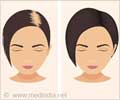From short and sassy bobs to long, cascading curls, the right hairstyle can make any woman look more pulled together.
From short and sassy bobs to long, cascading curls, the right hairstyle can make any woman look more pulled together. This is the reason why ladies, and men, give so much importance to tresses.
And for the same reason, hair loss can be particularly devastating. Therefore, dermatologists advise that it should be addressed at the first noticeable signs of a problem.While at the American Academy of Dermatology's Summer Academy Meeting 2009 in Boston, dermatologist Amy J. McMichael, MD, FAAD, associate professor of dermatology at Wake Forest University School of Medicine in Winston-Salem, N.C., discussed the different types of hair loss women experience and the current treatment options.
"Hair loss is a very misunderstood condition, both in terms of how people see their own hair loss and how physicians who are not dermatologists approach hair loss," said Dr. McMichael.
"It is important for women to be evaluated by a dermatologist, who specializes in hair loss, at the first signs of a problem - whether she notices that her ponytail is smaller than it used to be, she sees more hair in the shower, or if her part is widening. Determining the cause of the hair loss is the first step in treating it and preventing future hair loss," the expert added.
The most common form of hair loss in women is female-pattern hair loss, which is a hereditary condition also referred to as androgenetic alopecia.
Dr. McMichael explained that in both male- and female-pattern hair loss, the hair stays on the head for a shorter time due to a short growth phase, resulting in baby fine hairs that do not reach their full length or diameter.
Advertisement
Minoxidil 5 percent is only FDA-approved for male-pattern hair loss, but it has been shown to be very effective in women as well. Both the 2 percent and 5 percent solutions are available over-the-counter.
"Minoxidil is a wonderful option for women with thinning hair, as it only treats the hair you want to keep that is not reaching its maximum growth and is an easy way to fill in hair density," said Dr. McMichael.
"Although minoxidil is an over-the-counter treatment, women should consult their dermatologist who is experienced with the product and can explain how it works and off-set any known side effects - such as irritation or fine facial hair that could develop along the cheeks and jaw line," the expert added.
In some cases, other medications may be used off-label to treat female hair loss, including finasteride (which is FDA-approved for male-pattern hair loss) for women of non-childbearing age only, and the anti-androgens spironolactone and flutamide that work by blocking the male hormone testosterone at the cellular level of the hair follicle.
Another common form of hair loss in both men and women, telogen effluvium, refers to an increase in the number of hairs in the telogen, or rest, phase of the hair cycle, which typically lasts three months in the normal growth cycle. However, telogen effluvium occurs as a result of the body's natural physiologic response to some form of stress, causing more hair to enter the rest phase than the normal 10 percent.
"When I evaluate patients' hair and their recent medical history, I am able to determine if their hair loss is a result of telogen effluvium. I always tell women to be patient and that their hair needs to grow back on its own," said Dr. McMichael.
"In these cases, I would only recommend minoxidil to less than 50 percent of women and oral medications would not be effective. Once the trigger is removed, the hair simply needs to return to normal - which could take anywhere from three to nine months. The key is determining the trigger and when it occurred in relation to the hair loss," the expert added.
Source-ANI
TAN












